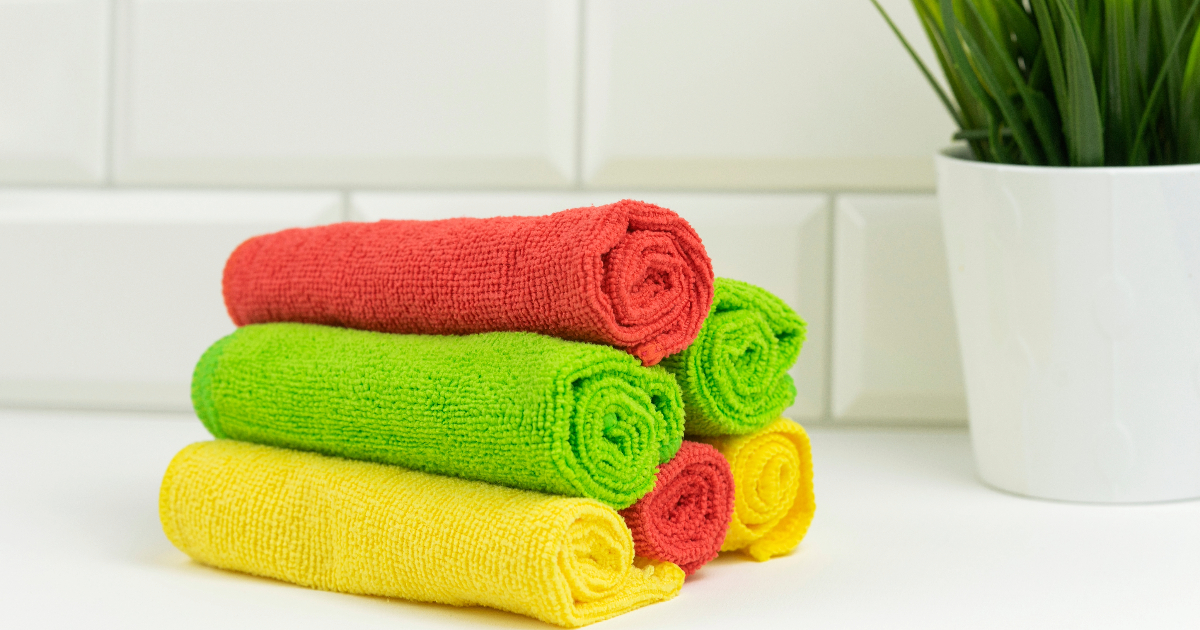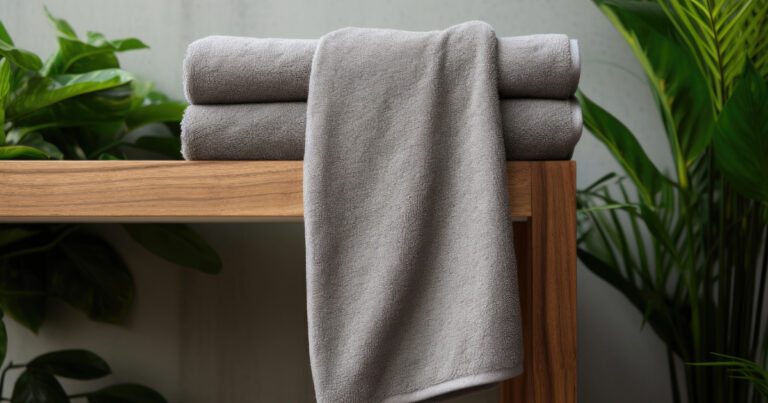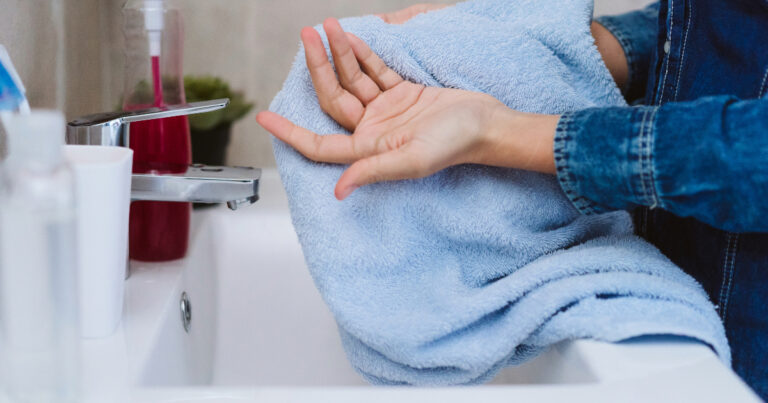Microfiber towels have become increasingly popular in recent years as an alternative to traditional cotton towels.

With claims of superior absorbency, softness, and faster drying times, microfiber seems like an ideal choice for bath towels.
What is Microfiber Made Of?
Microfiber refers to synthetic fibers that are thinner than human hair. These fibers are typically made from polyester, polyamide (nylon), or a blend of both.
The fibers are manufactured under heat and pressure to split them into even smaller fibers, creating a super fine and soft material. The fibers are then woven very densely to create microfiber fabric.
This tightly woven construction gives microfiber towels their features:
- Exceptional absorbency – The split microfibers create lots of surface area to absorb water.
- Quick-drying – With less space between fibers, moisture evaporates rapidly.
- Lightweight and thin – Microfiber requires less material to make absorbent fabric.
- Resistance to bacteria – The tight weave doesn’t allow bacterial growth.
- Durable – Synthetic microfibers are very strong.
- Lint-free – Tightly woven fibers don’t shed lint easily.
While these features make microfiber towels sound ideal, some downsides exist too. We’ll explore those next.
Pros of Microfiber Bath Towels
Microfiber offers some clear benefits over traditional cotton towels:
More Absorbent
The ultra-fine fibers in microfiber create lots of surface area to trap water molecules between the strands. This makes them exceptionally good at soaking up moisture quickly.
You won’t have to rub hard or repeatedly like with some cotton towels. Simply press a microfiber towel against your wet skin and it will draw water into the fibers rapidly.
Fast-Drying
One of the biggest complaints about cotton towels is how long they can take to fully dry. This leaves them prone to developing mildew and bacteria if not cared for properly.
Microfiber’s tightly woven construction contains less space between fibers. This allows moisture to evaporate much faster than from a fluffy cotton towel.
Hanging your microfiber towel to dry after use will have it ready to go again more quickly.
Lightweight and Compact
A single microfiber towel can often absorb as much water as a larger cotton towel, despite being thinner and more lightweight.
This makes microfiber a great choice for travel and trips to the gym. Microfiber towels take up little room in a suitcase or bag.
You can also comfortably carry a wet microfiber towel around without it becoming a bulky, heavy burden.
Durable and Long-Lasting
The synthetic fibers that makeup microfiber towels are extremely durable. They are designed to withstand frequent use and hundreds of washes over many years.
Microfiber won’t degrade or fall apart easily like natural fibers. With proper care, a quality microfiber towel will last a very long time.
Resists Odors and Bacteria
The tight weave of microfiber towels leaves little space for bacteria or odors to take hold. Microfiber has a natural resistance to bacterial growth.
Towels made from natural materials like cotton are more prone to developing mildew and smells if left damp. Microfiber’s quick drying times also help prevent this.
Cons of Microfiber Bath Towels
While microfiber clearly has some advantages, it’s not without a few disadvantages too:
Not as Plush and Comfortable
One of the nice things about cotton towels is their fluffy, luxurious feel. Cotton towels provide more cushioning and a cozy texture.
In contrast, microfiber has a thinner pile and sleeker feel. Microfiber likely won’t provide the same snuggly comfort you expect from a bath towel.
Can Irritate Sensitive Skin
The ultra-fine fibers that make microfiber so absorbent can be irritating to some people’s skin. Those with skin conditions like eczema are often sensitive to microfiber’s smooth texture.
The fibers act like tiny bristles that can scrape rather than soothe. For sensitive skin, cotton’s more breathable comfort may be preferable.
Not as Environmentally Friendly
Cotton and bamboo towels contain natural fibers that will eventually biodegrade. However, microfiber towels are made from synthetic plastics that remain in landfills.
There are also concerns around microfiber shedding microplastics when washed. These tiny plastic particles make their way into waterways and oceans.
Microfiber is convenient but not an eco-friendly choice. Opt for organic or sustainably grown natural fiber towels if you want a greener option.
Requires Special Care
While microfiber towels are quite durable, you do need to take special care of them. We’ll go over the specifics later, but key things to avoid are fabric softeners, bleach, and high heat.
With cotton towels, you have more leeway to toss them in the wash and dryer without worry. Microfiber requires a bit more attention when it comes to cleaning and drying.
Microfiber vs. Cotton Towels
How does microfiber really stack up against good-quality cotton towels?
| Microfiber | Cotton | |
|---|---|---|
| Absorbency | Excellent – ultra fine fibers | Good – depends on pile depth |
| Drying Time | Very fast – thin pile | Slow – thick and fluffy |
| Durability | Extremely durable from synthetic fibers | Prone to damage over time |
| Softness | Smooth and sleek feel | Luxuriously soft and plush |
| Eco-Friendly | Contains plastics that don’t biodegrade | Natural and biodegradable |
| Special Care | Avoid softeners, bleach, high heat | More flexibility in washing |
As you can see, each material has trade-offs. Microfiber excels at absorbency and drying quickly but feels less cozy. Cotton takes longer to dry but provides a plusher bath experience.
Consider which features are most important to you when deciding between microfiber vs cotton towels.
Key Takeaway: Microfiber bath towels have exceptional absorbency and dry very fast but may not feel as soft and comfy as high-quality cotton towels.
How Are Microfiber Towels Constructed?
Understanding how microfiber towels are made can help you identify quality materials and construction. Here are the key things to look for:
Materials Used
The specific mix of synthetic fibers impacts the towel’s performance and feel. Polyester and polyamide are the most common, but the ratio can vary.
- Higher polyamide content is softer but less durable.
- Higher polyester content is rougher but more durable.
Look for information on fiber ratios to pick the right blend for your preferences. A 70/30 polyester/polyamide blend is a good balance.
Fiber Density
Density measures how tightly packed together the fibers are when woven. Higher densities around 300-900 grams per square meter (gsm) equate to:
- Better absorbency – More fibers to absorb water.
- Faster drying – Tighter construction doesn’t hold water.
- Increased durability – Tightly packed fibers are stronger.
Browse product details to find the gsm or density information before buying.
Construction Method
Microfiber bath towels can be woven in a few different ways:
- Looped pile – Most similar feel to cotton towels.
- Cut pile – Sheared loose fiber ends make a velvety feel.
- Waffle weave – Grid pattern for faster drying.
Handles and edges may also be surged or hemmed for durability. Prioritize double stitching for strength.
Dyes Used
Pay attention to whether low-impact dyes are used, especially for brighter colors. Synthetic dyes can contain harmful chemicals. Look for towels dyed with vegetable or natural dyes.
Certifications
Reputable environmental certifications indicate more sustainable practices were used in production. These include OEKO-TEX, Global Organic Textile Standard (GOTS) and STANDARD 100 by OEKO-TEX.
Key Takeaway: Higher polyamide content gives softer microfiber towels, while higher polyester makes them more durable. Look for around 300 gsm density and looped or waffle pile construction.
How to Care for Microfiber Towels
To get the most life out of your microfiber towels, follow these care tips:
- Wash new towels first – This prevents dye transfer onto another laundry.
- Use mild detergent – Harsh chemicals can damage the fibers.
- Wash similar colors – Avoid washing with fabrics that could lint.
- Cold water wash – Hot water can melt the synthetic fibers.
- Low heat or air dry – High heat causes pilling and accelerates decay.
- Avoid softeners – They coat the fibers and reduce absorbency.
- Skip the bleach – Bleach degrades the microfiber material.
- Don’t overload the washer – Too many towels may not get fully clean.
- Shake out before drying – Prevents excess pilling and clumping.
Follow these simple guidelines and your microfiber towels will last for years to come.
When Are Microfiber Bath Towels Ideal?
Here are a few instances where microfiber bath towels can be particularly useful:
- Travel – Extremely lightweight and compact.
- Gym bags – Fast absorbing and antimicrobial.
- Camping/beach – Don’t hold sand, fast to dry.
- Small spaces – Thin and absorbent, take up less storage space.
- Children/baby – Very soft and gentle on the skin.
- Elderly/assisted living – Easy to launder and keep clean.
- Hot and humid climates – Resist odors and mildew in damp conditions.
- Eco-friendly gift – Synthetic and recyclable option.
Are Microfiber Bath Towels Worth It?
Microfiber bath towels offer exceptional absorbency and dry time compared to cotton. But they come at the cost of plushness and eco-friendliness.
Here are some instances when microfiber bath towels may be your best option:
- You need ultra-fast drying towels at the gym or pool.
- You want super compact and lightweight towels for travel.
- You live in a hot, humid environment where towels stay damp easily.
- You don’t like how long cotton towels take to dry out.
- You want antimicrobial towels for areas prone to bacteria buildup.
However, for everyday home use, high-quality organic cotton likely remains the favored choice for comfort and sustainability.
FAQs
Are microfiber towels antibacterial?
The tight weave of microfiber towels leaves little space for bacteria to grow. Microfiber’s synthetic composition also resists bacterial buildup naturally. This makes them more hygienic than cotton towels in damp environments prone to mold and mildew growth.
Why do microfiber towels smell?
Microfiber towels should not retain odors when washed properly. However, harmful bacteria can build up if not cleaned thoroughly or dried fully, leading to musty smells. Bleach can help sanitize microfiber towels to prevent this. White vinegar or baking soda soaks can also help remove odors from microfiber towels.
How do you soften microfiber towels?
Avoid using fabric softener on microfiber towels, as it coats the fibers and reduces absorbency. For softer microfiber towels, use a mild liquid detergent and wash in cold water. Don’t use bleach. Dry completely to maintain softness. For added softness, dry the towels with a few clean tennis balls. The agitation helps fluff the towels.
Can you put microfiber towels in the dryer?
Yes, you can dry microfiber towels in the dryer but use the lowest heat setting possible. High temperatures can damage and melt synthetic microfibers. Excessive heat causes microfiber towels to pill faster. For best results, reshape and smooth towels before air drying or drying on a low or no heat setting.
How long do microfiber towels last?
With proper care, a good quality microfiber towel can last 5 years or more. Lower-quality microfiber may only last a year with regular use. Avoiding harsh detergents, fabric softener, and heat during washing and drying will maximize the lifespan of microfiber towels. Higher density microfiber around 300-900 GSM will be the most durable and long-lasting.
Conclusion
Microfiber bath towels provide some clear benefits, especially when fast drying and absorbency are your top priorities. But the trade-offs around comfort and environmental impact are worth considering too.
Look at the specific fiber blend, density, construction, and certifications when shopping to find the best microfiber bath towels. And take care to wash them properly to maximize their longevity.
For plushness and sustainability, organic cotton bath towels may be preferable for general home use. But for certain situations where fast-drying and highly absorbent towels are needed, microfiber is an ideal choice.








